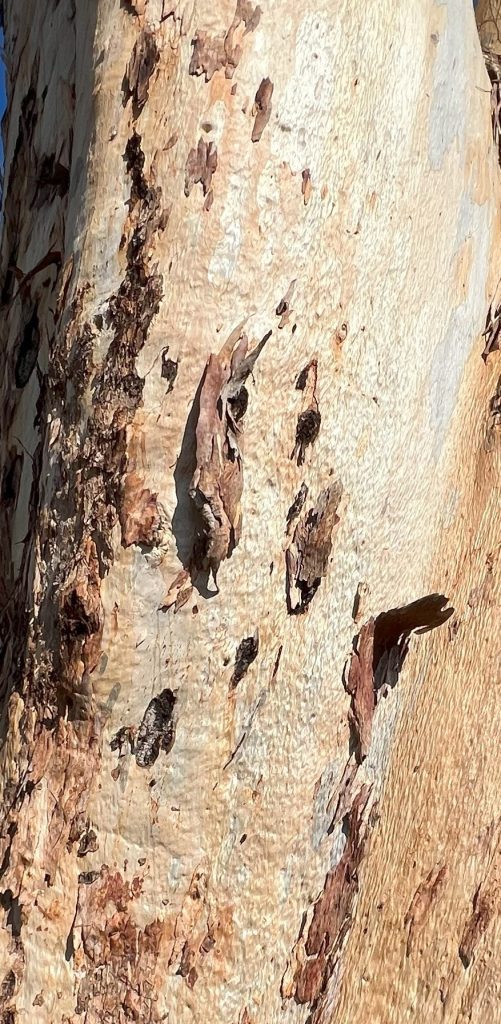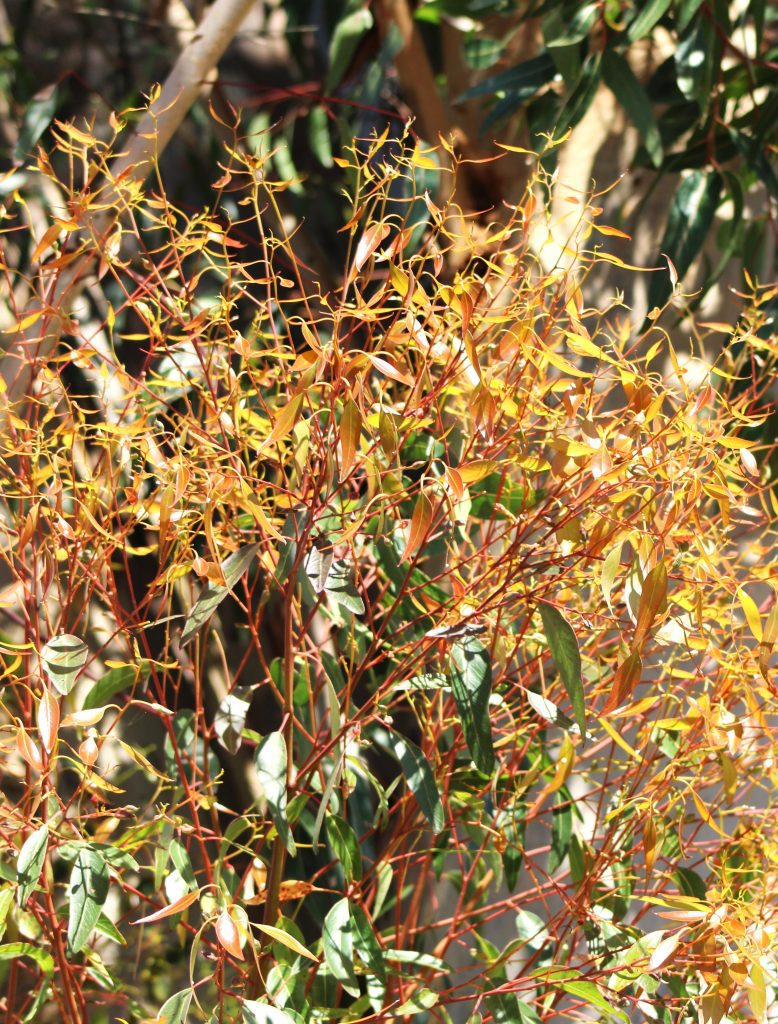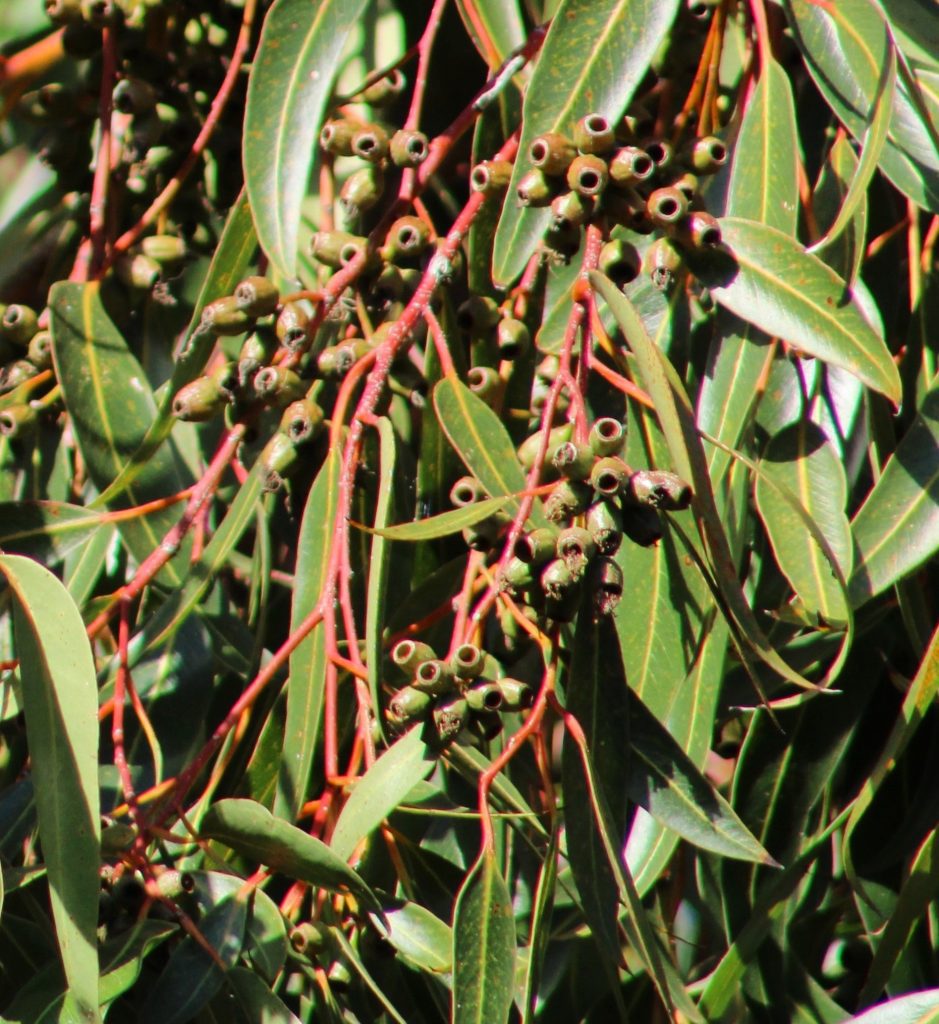March Tree of the Month: Sugar Gum

Eucalyptus cladocalyx
One of the most picturesque skyline trees in Santa Barbara is the Sugar Gum. Its long branches reach upward like outstretched arms toward the sun. This month, its majestic appearance is enhanced by a covering of new leaves – glossy and yellow-bronze in color.
Notably, Santa Barbara is home to the National Champion Sugar Gum – the enormous tree that stands at the north end of the Mission Park Rose Garden. In 2015, it was measured and found to be over 110-feet tall with a trunk diameter (at 4½ feet above the ground) of nearly 7-feet wide. An amazing size for a tree believed to be only a little over 100-years old. Obviously, Sugar Gum is well suited to our climate and growing conditions!
Sugar Gum is a broadleaf evergreen tree that bears an open crown over 100-feet tall and 70-feet wide. At the end of each branch grow large tufts of foliage; these give each branch the odd appearance of being another tree growing epiphytically upon the primary tree.

One of the most striking features of Sugar Gum is its lovely bark. The outer-bark sheds off cleanly to reveal a smooth under-bark surface that is usually a mottled yellowish white – but can have patterns with areas of gray, orange, or blue-gray added in. This clean surface distinguishes Sugar Gum from its relatives in the Eucalyptus genus that do not shed their barks entirely at one time. Older Sugar Guns frequently develop long vertical cracks in their bark.
Adult leaves are shiny and lanceolate-shaped (3- to 6-inches long and ½- to 1-inch wide); these are arranged alternately on thin reddish stems. They are darker green on the top and lighter green underneath and carry a prominent yellowish middle vein with visible lateral veins. When crushed, they exude the refreshing scent of Eucalyptus oil.

In late winter through spring, creamy-white flowers appear within the tree’s crown. The flowers are produced on leafless stems in clusters of seven or more flowers. Their buds (½-inch long) are cylindrical or urn-shaped. These are “perfect flowers”, meaning each flower has both male parts (stamens) and female parts (pistils). The tiny flowers (¾ -inch wide) look like they have fluffy petals; in fact, they have no petals – the appearance is created by dozens of ¼-inch long stamens that stand upright together in a crowning circle above the bud base.
The flowers attract bees eager to forage on the pollen and nectar. They arrive in such numbers that a loud hum can be heard when one stands beside a tree in full bloom. Beekeepers know that bees gorging on Sugar Gum flowers will produce large quantities of delicious, Eucalyptus-fragrant, honey.
After the flowers are pollinated, the seeds that develops are contained in hard, brown, barrel- to slightly urn-shaped seed capsules (½-inch long and ¼-inch wide). Each capsule can contain dozens of tiny seeds that will be dispersed by the wind.

Sugar Gum is endemic to the Australian state of South Australia, which has a Mediterranean climate like ours, in three isolated populations: the Flinders Ranges; the Eyre Peninsula; and, Kangaroo Island. In these native populations, trees can vary widely in size and growth habits; consequently, three distinct subspecies have been described in Australia.
Sugar Gum’s common name comes from its exceptionally sweet flower nectar. Its botanical name is Eucalyptus cladocalyx. The genus name, Eucalyptus, is a combination of the Greek words “eu” (meaning “well”) and “kalypto” (meaning “covered”) – it refers to the woody caps that protect the flower buds. The specific epithet, cladocalyx, is a combination of the Greek words “klados” (meaning “branch”, “twig” or “stem”) and “kalypto” – again referring to the bud caps.
This tree is best planted in full sun. It prefers sandy loam soils – but will tolerate clay and rocky soils. It is quite drought-, heat-, and frost-tolerant, which makes it adaptable to a warm and dry climate. It is not affected by any serious insect pests or diseases and is resistant to soil fungi.
In California, Sugar Gum has been planted extensively as an ornamental tree and for windbreaks in orchards. In Australia and worldwide, its dense and termite-resistant wood is used in construction, furniture, fence posts, poles, railroad ties, and firewood. It is appreciated as a pollinator for honeybees.
Because it is a big and fast-growing tree, it is one of the best ornamental choices for larger properties, parks, and open-space public plantings. It is considered one of the most stable and wind-resistant of the Eucalyptus – and one that produces minimal bark and leaf litter. Its impressive size at maturity makes it appropriate for areas that need large-scale trees to match the surrounding infrastructure. Not surprisingly, it has been used extensively along freeways and other expansive areas to give a dramatic skyline effect.
In addition to the National Champion above the Mission Park Rose Garden, some of the best Sugar Gums can be seen along our highways: on Highway 101 from Castillo Street to Fairview Avenue (mixed with a few other Eucalyptus species); on the south side of Highway 101 at the Las Positas exit; and, on Highway 145 just north of Calle Real. On local streets, they stand on the east side of the 2900 block of Las Positas Road and on the 1100 and1200 blocks of Coast Village Road (mixed with other Eucalyptus species). A dramatic stand borders both sides of Park Lane in Montecito.
Tree-of-the-Month articles are sponsored by Santa Barbara Beautiful, whose many missions include the increase of public awareness and appreciation of Santa Barbara’s many outstanding trees and, in a long-time partnership with the City Parks & Recreation Department, the funding and planting of trees along the City’s streets.
Those who wish to honor a special someone can do so with an attractive commemorative marker that will be installed at the base of an existing street tree in the City of Santa Barbara. Because Santa Barbara Beautiful has participated in the planting to date of over 13,000 street trees, there are plenty of trees from which to choose! Application forms are available on the Santa Barbara Beautiful website, www.sbbeautiful.org.
Article and Photos by David Gress
Comments
0 Comments deleted by Administrator
Leave a Review or Comment
You must be logged in to post a comment.















It’s a gorgeous tree. But I need to caution you, there is a movement to cut down eucs because of the fire potential they have and they are non native.
Its gorgeous
I’m watching my 80′ tall Euc street tree, as it dances around in this wind we’ve got going today. (A “Swamp mahogany,” miles from any swamp land.) I often wonder if such movement makes the trees feel happy. Hopefully, the Red-shouldered hawks’ nest won’t blow down. They may want to re-use it next year. The hawks had a successful hatching of at least two young. First time ever to have them nesting in that Euc. Whew —— The wind is really gusting. There goes the predicted rain . . .